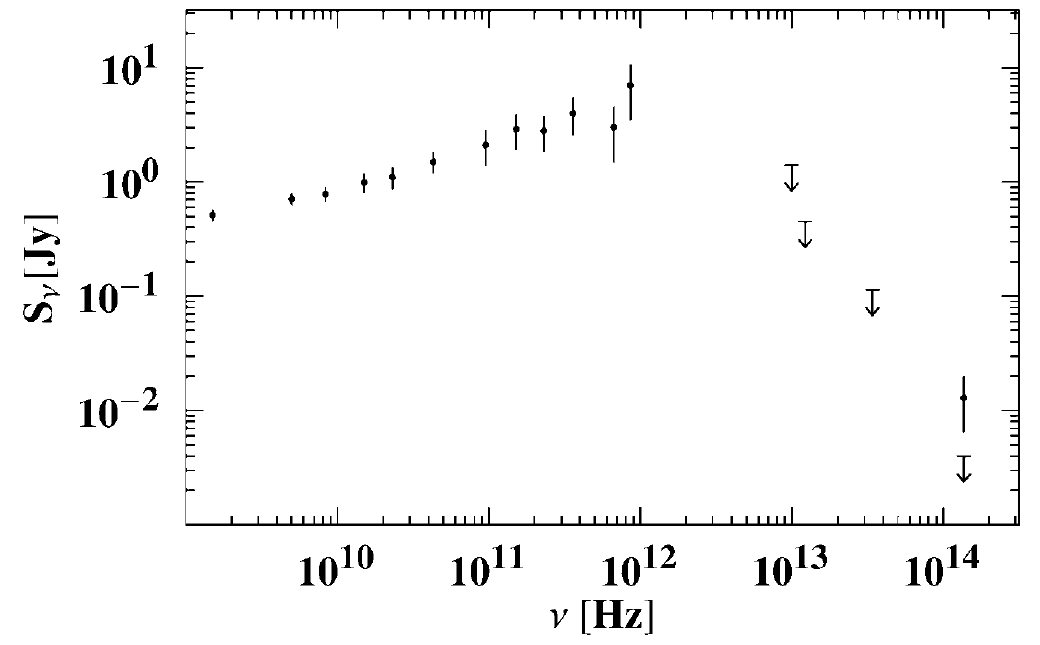


 الفيزياء الكلاسيكية
الفيزياء الكلاسيكية
 الكهربائية والمغناطيسية
الكهربائية والمغناطيسية
 علم البصريات
علم البصريات
 الفيزياء الحديثة
الفيزياء الحديثة
 النظرية النسبية
النظرية النسبية
 الفيزياء النووية
الفيزياء النووية
 فيزياء الحالة الصلبة
فيزياء الحالة الصلبة
 الليزر
الليزر
 علم الفلك
علم الفلك
 المجموعة الشمسية
المجموعة الشمسية
 الطاقة البديلة
الطاقة البديلة
 الفيزياء والعلوم الأخرى
الفيزياء والعلوم الأخرى
 مواضيع عامة في الفيزياء
مواضيع عامة في الفيزياء|
Read More
Date: 10-2-2017
Date: 2-2-2017
Date: 2-2-2017
|
Radio spectrum of Sgr A*
A major input for modeling the nature of the central black hole candidate of our Galaxy is the emission spectrum. Typical luminous black holes, e.g. those in quasars, emit over a broad range in frequencies. In contrast, for Sgr A* only radio emission was reliably detected over many years, with the late addition of X-ray emission. One reason for this dimness is certainly the low accretion rate and quite plausibly the presence of a radiatively deficient accretion flow.
At frequencies below 1 GHz the spectrum is essentially undetermined. First of all, the scattering size of Sgr A* becomes larger than 1 arcsecond and the source starts to blend with its surroundings. Second, the Sgr A complex becomes optically thick at low frequencies (Pedlar et al 1989) and Sgr A* may be obscured. It is also possible, but less likely, that the claimed low-frequency turnover in the spectrum (Davies et al 1976) has an intrinsic nature.
At higher frequencies the radio spectrum of Sgr A* has been measured with great accuracy in various campaigns up to the THz regime (e.g. Wright and Backer 1993, Zylka et al 1995, Serabyn et al 1997, Falcke et al 1998). Since the source is variable, it is useful to consider either simultaneous or time averaged spectra. Such an average spectrum is shown in figure 1.1compiled by Melia and Falcke (2001). The overall radio spectrum is slightly inverted, i.e. it has a positive spectral index (α  0.2, Sν ∝ να) in the GHz regime. The average radio flux density is around 1 Jy. At the highest radio frequency (> 100 GHz), the spectrum seems to become even more inverted until it abruptly cuts off somewhere in the far-infrared. This upturn and subsequent cut off has been interpreted as an effect of the finite size of the central object with a size scale as expected for a 3 × 106 Mּ black hole (e.g. Falcke and Biermann 1994 and later). The up-turn in the spectrum at sub mm wavelengths is often referred to as the ‘sub mm bump’.
0.2, Sν ∝ να) in the GHz regime. The average radio flux density is around 1 Jy. At the highest radio frequency (> 100 GHz), the spectrum seems to become even more inverted until it abruptly cuts off somewhere in the far-infrared. This upturn and subsequent cut off has been interpreted as an effect of the finite size of the central object with a size scale as expected for a 3 × 106 Mּ black hole (e.g. Falcke and Biermann 1994 and later). The up-turn in the spectrum at sub mm wavelengths is often referred to as the ‘sub mm bump’.

Figure 1.1. Time-averaged spectrum flux density versus frequency of Sgr A* from radio to the near-infrared as compiled by Melia and Falcke (2001). The error bars in the radio regime indicate variability (one standard deviation).



|
|
|
|
للعاملين في الليل.. حيلة صحية تجنبكم خطر هذا النوع من العمل
|
|
|
|
|
|
|
"ناسا" تحتفي برائد الفضاء السوفياتي يوري غاغارين
|
|
|
|
|
|
|
نحو شراكة وطنية متكاملة.. الأمين العام للعتبة الحسينية يبحث مع وكيل وزارة الخارجية آفاق التعاون المؤسسي
|
|
|